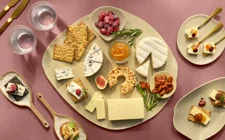
Traditional Danish Blue (PGI)
What is Danish Blue (PGI)?
The quintessence of fine dining since its origin, Danish Blue cheese exudes self-indulgence at the highest level. Also known as Danablu, the cheese is made using cow’s milk and displays fine streaks of blue veins along its white interior. Resembling Danish royal porcelain, it enchants with tones of mild bitterness and salt. The flavours are pungent and sharp, with a creamy and smooth texture on par with many soft cheeses.
Adopting traditional French recipes for making blue mould cheese, dairy farmers on the island of Funen in Denmark replaced goat’s milk with cow’s milk to better fit the profile of a creamy and rich consistency. Danish Blue is appreciated for its mildness, making it a popular choice for those who prefer gentler flavours.
Pair Danish Blue with seared beef, veal or pork steak, allowing it to melt in, or serve it in soups, pastas or stews for an extraordinarily creamy consistency. Enjoyed cold, zesty apple, dark chocolate and pear stand in great contrast and complement the flavours beautifully by subduing the sharper tones of the cheese – a great way of introducing sceptic audiences to blue cheese.
How Danish Blue (PGI) is made
Finding a balance between piquancy and smoothness, Danish dairies select their milk with great care and purpose, committed to the notion of wholesome milk being reflected in the final quality. Danish Jersey and red-pied cows are chosen for their high yield and rich milk.
Taken fresh from the pasture, the milk is pasteurised and prepared in large vats. To help foster the blue veins, blue culture is mixed with the milk, along with a combination of enzymes and rennet to trigger coagulation.
When left to sit, the mixture curdles the milk, producing a firm curd that is then cut and milled. The broken curd is ladled into moulds and drained of excess whey, followed by a brine consisting of salt and water.
Before it is ready to age, the cheese is pierced with steel needles, leaving room for the blue culture to breathe and develop. Aging takes about 60 days, producing a smooth and velvety wheel of Danish Blue cheese.
Pick another Blue Mould Cheese
If you appreciate the qualities of Danish Blue there are other cheeses you might enjoy.
Gorgonzola (PDO), an Italian cheese, is known for its soft and crumbly texture, paired with a bold and brash taste. Made from cow’s milk, it serves a variety of culinary roles and offers a slightly salty flavour.
Roquefort (PDO), crafted from sheep’s milk, is recognized for its sharp taste and crumbly texture. It provides a distinctive and aromatic experience with its blue veins and rich flavours.
Curious about the world of cheese? Here's everything you need to know about how to store, serve and cut cheese!











